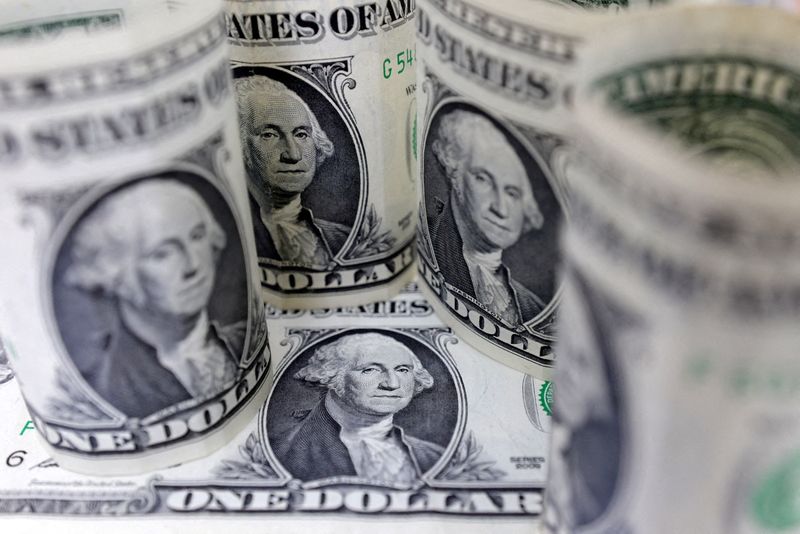Forex
Dollar rally stalls after rare FX warning from finance chiefs

By Amanda Cooper
LONDON (Reuters) – The dollar fell for a second day on Thursday after a rare warning by the finance chiefs of the United States, Japan and Korea over the sharp decline in other currencies, which in turn offered the yen some rare respite.
The yen got a modest lift after Japan’s top currency diplomat Masato Kanda said finance leaders of the G7 reaffirmed their stance that excessive currency volatility was undesirable.
Strong U.S. economic data and persistent inflation have prompted investors to drastically rethink the chances of the Federal Reserve cutting rates any time soon. Tension in the Middle East has also added to the dollar’s safe-haven appeal.
The upshot has been that other currencies, particularly in Asia, have been battered. The yen has been pinned near 34-year lows, prompting several warnings from Japanese authorities as traders fret about possible intervention.
The United States, Japan and South Korea agreed to “consult closely” on foreign exchange markets in their first three-way finance dialogue on Wednesday, in a nod to the concerns of Tokyo and Seoul over their currencies’ recent sharp declines.
“It sends another strong signal to market participants that Japan and Korea are moving closer to stepping into the FX market, while at the same time officials from Japan and Korea will be hoping that the joint statement with the U.S. helps to strengthen the credibility of verbal intervention as well,” said MUFG strategist Lee Hardman.
The Japanese currency strengthened to 153.96 against the dollar on Thursday before paring gains. The dollar was last flat at 154.43 yen, within sight of Tuesday’s 34-year low of 154.79.
Market participants have raised the bar on possible intervention by Japanese authorities to prop up the yen, now pinpointing the 155 level from 152 previously, even if they believe Japan could step in at any time.
Still, given the dollar’s broad strength, Wei Liang Chang, a currency and credit strategist at DBS, said their models suggest the risk of intervention may even have shifted to the 156 range, as Japanese authorities consider the yen’s performance against a handful of other currencies that have depreciated.
The yen has lost some 8% in value against the dollar in 2024, but it has fallen against other currencies as well, to stand down nearly 5% against the euro and down almost 7% against the .
Japan last intervened in the currency market in late 2022, spending an estimated $60 billion to defend the yen.
EURO, STERLING EDGE UP
The euro held steady at $1.0676 after Wednesday’s 0.5% gain, pulling away from a five-month low touched on Tuesday. Sterling was last up 0.21% at $1.248.
The , which measures the U.S. currency against six others, was last down 0.11% at 105.84 but still within reach of this week’s 5-1/2-month high of 106.51 hit on Tuesday. The index is up 4.5% this year.
Markets are barely pricing in half a percentage point in cuts from the Fed this year, compared with an expectation for at least six quarter-point cuts at the start of the year.
Traders see September as the most likely starting point, versus June just a couple of weeks ago, based on the CME FedWatch Tool.
U.S. economic activity expanded slightly from late February through early April and firms signalled they expect inflation pressure to hold steady, a Federal Reserve survey showed on Wednesday.
Fed Governor Michelle Bowman said progress on slowing U.S. inflation may have stalled, and it remained an open question whether rates were high enough to ensure inflation returned to the Fed’s 2% target.

“In our view, it will take a run of lower CPI readings for the FOMC to cut interest rates in September,” said Kristina Clifton, senior economist at Commonwealth Bank of Australia (OTC:).
In cryptocurrencies, bitcoin rose 1.7% to $61,700 ahead of the widely anticipated halving event in the next few days.

 Forex3 years ago
Forex3 years agoForex Today: the dollar is gaining strength amid gloomy sentiment at the start of the Fed’s week

 Forex3 years ago
Forex3 years agoUnbiased review of Pocket Option broker

 Forex3 years ago
Forex3 years agoDollar to pound sterling exchange rate today: Pound plummeted to its lowest since 1985

 Forex3 years ago
Forex3 years agoHow is the Australian dollar doing today?

 Cryptocurrency3 years ago
Cryptocurrency3 years agoWhat happened in the crypto market – current events today

 World3 years ago
World3 years agoWhy are modern video games an art form?

 Commodities3 years ago
Commodities3 years agoCopper continues to fall in price on expectations of lower demand in China

 Economy3 years ago
Economy3 years agoCrude oil tankers double in price due to EU anti-Russian sanctions


































